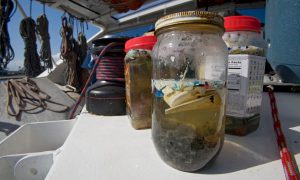Recent research has shown that deep sea sediments are a likely sink for microplastics. Studies in the Arctic Ocean, the Mediterranean Sea, and the Southwest Indian Ocean show an abundance of plastic debris. Deep-sea coring was used as a method of sampling.
Since plastic is extremely durable, there is difficulty in disposing of the matter, which is why it accumulates in the natural environment. The plastic in the deep sea could have come from a multitude of origins; humans use plastic religiously. We have plastic in our computers, to carry our groceries, and in many other daily objects. Other sources could be fishing waste, shipyards, or municipal drainage systems.
The plastics could have travelled north by way of the ice floes in the Thermohaline Circulation, ocean circulation that is controlled by density differences. Microplastics have a smaller surface area than other plastic debris, so they are less buoyant, which makes them sink faster. Then, the plastics are deposited on the seafloor.

The generation and deposition of plastics in the oceans
Multiple research expeditions collected deep-sea sediment cores from basins, submarine canyons, seamounts (a submarine mountain), and continental slopes (the sea floor before the break of the waves). According to the article, The Deep Sea is a Major Sink for Microplastic Debris, “ten centimetre diameter cores were obtained from megacorers or boxcores that were subsequently subsampled.” Megacorers take wide samples in plastic tubes with a weight and suction system. Boxcorers take 600 millimeter square samples. In another study, scientists took samples by video guided multiple corers, which took eight cores. Multiple corers can take up to twelve undisturbed cores in plastic tubes. Coral specimens from different seamounts were also taken and observed.
The different sampling methods proved to be most explanatory. According to Royal Society Open Science, “275 million metric tons (MT) of plastic waste was generated in 192 coastal countries in 2010, with 4.8 to 12.7 million MT entering the ocean” (Plastic waste inputs from land into the ocean.) The Royal Society Open Science also “confirmed that microplastics were abundant in all 12 sediment samples and all coral samples” and found that microplastics were found on every strata level ranging down to a depth of 3,500 meters. This prevalence of microplastic in all levels of their sampling and in all of the coral types sampled spanning many seas reveals that there is a great deal of plastic in the deep sea.
The increase of plastics in the deeps sea negatively impacts shipping, tourism, and majorly affects wildlife. It affects many marine organisms by being taken in at the lowest level on the food chain. Microplastic “is of particular concern because it can be taken up by a wider range of biota (>172 species) and can be propagated in food webs” (High Quantities of Microplastic in Arctic Deep-Sea Sediments.) One of the most remote places on the earth, the deep Arctic sea, is being polluted by plastic waste. This is important to know and understand so that we can make reparations. Action must be taken to reduce our plastic production.
Links:
https://phys.org/news/2017-08-marine-microplastics-bottom-dweller-bellies.html
https://www.ncbi.nlm.nih.gov/pmc/articles/PMC6076259/
Citations:
Woodall LC et al. 2014 The deep sea is a major sink for microplastic debris.R. Soc. open sci. 1:http://dx.doi.org/10.1098/rsos.140317
High Quantities of Microplastic in Arctic Deep-Sea Sediments from the HAUSGARTEN
Observatory Melanie Bergmann, Vanessa Wirzberger, Thomas Krumpen, Claudia
Lorenz, Sebastian Primpke, Mine B. Tekman, and Gunnar Gerdts. Environmental
Science & Technology 2017 51 (19), 11000-11010 DOI: 10.1021/acs.est.7b03331
Plastic waste inputs from land into the ocean J. R. Jambeck, R. Geyer, C. Wilcox, T. R. Siegler, Perryman, A. Andrady, R. Narayan, K. L. Law, Science (Washington, DC, U. S.)(2015), 347 (6223) 347 768-771 CODEN: SCIEAS ISSN: 0036-8075
Renfrew, Colin, and Paul Bahn 2010 Archaeology Essentials. 2nd ed. Thames & Hudson,
New York.
Getty Images. “Samples of plastic waste level in ocean water taken in the North Pacific.” The
Guardian, Adam Vaughan 2018 Guardian News and Media Limited
“Seafloor Sampling.” Edited by Oceanography Center National, When Did Modern Rates of Sea Level Rise Start? | National Oceanography Centre, 2018, noc.ac.uk/facilities/national-marine-equipment-pool/scientific-engineering/seafloor-sampling.
Eunomia, Research and Consulting. Eunomia Marine Litter.
Riebeek, Holli. “Paleoclimatology: Explaining the Evidence.” NASA, NASA, 9 May 2006,
earthobservatory.nasa.gov/Features/Paleoclimatology_Evidence.


How does this presence of plastics in our sea challenge archaeology in the ocean? Are these pieces of plastic obscuring data or making it harder for archaeologists to study in the sea?
Plastics are obscuring archaeological evidence in the ocean, particularly in deep sea shipwrecks. For example, HMS Invincible’s wreck site in Portsmouth Harbor is polluted by a large accumulation of plastics. Kevin Stratford, from the Marine Archaeology Sea Trust, says that wrecks act as accumulation points for plastics in the ocean. Stratford also said that many other wrecks he had encountered were similarly polluted with plastics. The divers and archaeologists have to sort through all of the debris before uncovering the actual artifacts r features. This pollution costs money and the time of everyone involved. There is little to no evidence of the plastics harming or disturbing archaeological sites, but there is evidence that the plastics affect the marine wildlife inhabiting the shipwrecks.
Knapton, Sarah
October 17, 2018 Ocean plastic now polluting shipwrecks and desecrating war graves of servicemen lost at sea, warn divers
Telegraph Media Group Limited, Jersey, United Kingdom